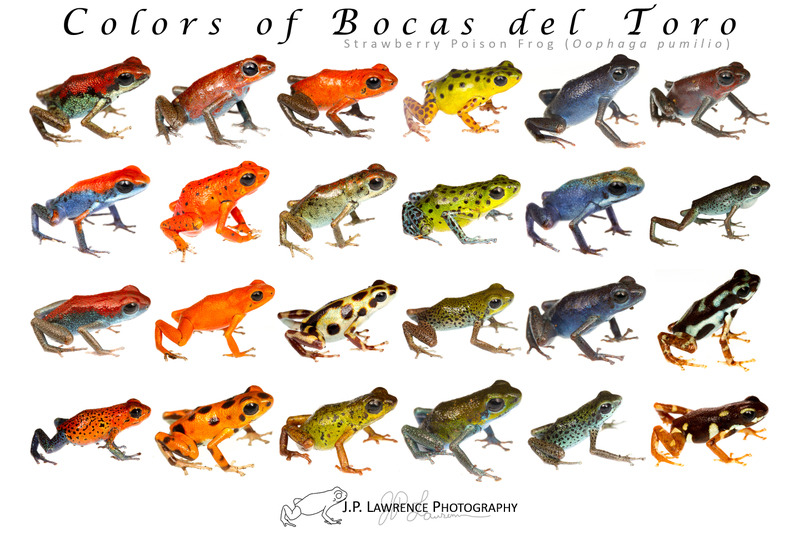顏色夠警戒就不用躲了?多態型的草莓箭毒蛙的顏色與逃避行為的關聯性
photo from J. P. Lawrence
摘要
The phenomenon of aposematism, or the pairing of antipredator defence with conspicuous or distinctive signals, serves as an excellent example of how traits act in concert to shape fitness. Not only does this complex phenotype require the integration of multiple traits, it alters the fitness pay-offs of yet others. The protection offered by aposematism may, for example, reduce the costs associated with foraging or sexual display. Thus, well-protected aposematic lineages should be bolder, more active and less likely to respond to perceived threats of predation than more cryptic lineages. Comparisons of differently coloured morphs of the poly-typic strawberry poison frog (Oophaga pumilio) have supported the predicted behavioural correlates of aposematism, with the exception of those regarding responsiveness to simulated predators. We tested the key prediction that aposematic coloration will be associated with reduced sensitivity to predators in two polymorphic O. pumilio populations. The novel approach of studying polymorphic populations allowed us to assess the effect of colour in the absence of potentially confounding habitat differences. We found that colour was associated with the probability that a frog would attempt escape and the distance at which it fled, but only in one population, and not in the predicted direction. An overall comparison of the two populations superficially supported our predictions, but this pattern actually arose because frogs occupying higher perches were less likely to respond, a pattern that may reflect the value of high perches and the costs associated with returning to them after attempted escape. These results highlight the complexity of the relationship between predators and prey, the challenges associated with understanding how and why traits are correlated, and the intimate ties between behaviour and morphological evolution.
警戒色是生來嚇阻警告捕食者,告訴牠們「我不好吃別吃我」的視覺訊號,這對擁有警戒色的物種的好處是避免被攻擊與提高生存率。既然如此,是不是就代表這些物種在外出覓食或是求偶的時候,可以花費比較少的能量躲避捕食者呢?(就是我夠兇不用躲的意思)
這個研究用草莓箭毒蛙 (Oophaga pumilio)做為研究對象,草莓箭毒蛙本身就是具有多態性的物種,從看起來警戒到看起來隱蔽的樣式都有,因此可以降低不同種間遺傳結構所產生的行為差異,很適合做為討論這個問題的標的物種。作者選定兩個地方的族群 Isla Bsastimentos與Dolphin bay (都在巴拿馬),作者實際到這兩處的雨林中蒐集資料,透過穿越線的方式找尋野生的個體,然後以人類做為捕食者慢慢靠近的方式進行實驗。首先選定兩個類型的體色:有警戒色的與比較黯淡的,評估族群間是否有體色上的差異(沒差,有差就不用做了),接著評估兩種行為1) 個體看到捕食者時是否企圖要逃跑 2) 捕食者與個體開始逃跑間的最短距離 (flight initiation distance, FID)。結果顯示兩個區域間企圖逃跑的比例不一樣,在Bastimentos的族群有企圖逃跑行為的比Dolphin Bay的要少,如果與顏色有關的話,那麼兩者間的比例應該會很接近,這邊顯示只有其中一個族群反應作者的假說。另一個分析顯示這些個體要不要討跑與所停的高度(perch height)比較有關,與作者的假說相關度比較低,顯示停棲高度可能與對能不能發現捕食者,進而引發逃跑反應比較有影響。
其實這個研究的前提有點弔詭,如果一個物種有防禦+有亮眼的顏色=警戒性,那麼有防禦+黯淡的顏色就不等於警戒性了嗎?因為個體還是有毒,因此這個「黯淡的顏色」還是有可能被天敵當成某種避忌訊號,只是以人類的視覺角度來看的話,就會變成沒有要不要逃跑取決於其他因子而不是因為有沒有警戒色。





0 comments